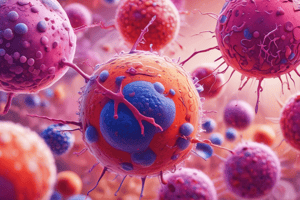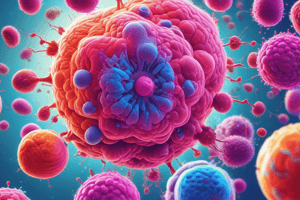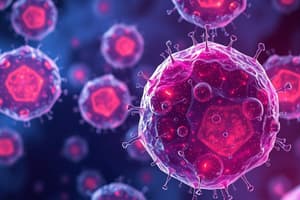Podcast
Questions and Answers
What is the role of chemokines in T cell differentiation?
What is the role of chemokines in T cell differentiation?
Chemokines signal naive T cells to enter the paracortex of secondary lymphoid organs and encounter antigen presenting cells (APCs) with an antigen/peptide bound to MHC.
What happens to naive T cells that do not encounter antigen bound to MHC?
What happens to naive T cells that do not encounter antigen bound to MHC?
Naive T cells that do not encounter antigen bound to MHC leave the lymphoid organ through efferent lymphatics and recirculate.
What is the function of high endothelial venules (HEVs) in T cell trafficking?
What is the function of high endothelial venules (HEVs) in T cell trafficking?
HEVs are blood vessels adapted for lymphocyte trafficking and are found in secondary lymphoid organs. They allow T cells to enter the lymphoid tissue and encounter antigen presenting cells.
What is the central event in the generation of humoral and cell-mediated immune responses?
What is the central event in the generation of humoral and cell-mediated immune responses?
Where are high endothelial venules (HEVs) commonly found?
Where are high endothelial venules (HEVs) commonly found?
Study Notes
Chemokines and T Cell Differentiation
- Chemokines are signaling proteins that regulate the movement and differentiation of T cells during immune responses.
- They help naïve T cells migrate to the lymph nodes where they can encounter antigens and activate.
- Specific chemokines attract T cells to different tissues, influencing their development into various subsets (like Th1, Th2, or cytotoxic T cells).
Fate of Naive T Cells
- Naive T cells that do not encounter antigen bound to MHC undergo apoptosis (programmed cell death) after a certain period.
- This process helps maintain immune homeostasis and prevents excessive accumulation of non-functional T cells.
High Endothelial Venules (HEVs) and T Cell Trafficking
- HEVs are specialized blood vessels found in lymph nodes that facilitate the entry of T cells from the bloodstream into the lymphatic system.
- They express specific adhesion molecules and chemokines that promote the binding and migration of lymphocytes.
- HEVs play a critical role in the recruitment of T cells to sites of inflammation and immune activation.
Central Event in Immune Response Generation
- The central event in generating humoral and cell-mediated immune responses is the activation of T cells by antigen-presenting cells (APCs) through MHC molecules.
- This activation triggers a cascade of immune responses, including the differentiation of B cells into plasma cells and the activation of cytotoxic T cells.
Locations of High Endothelial Venules (HEVs)
- HEVs are predominantly found in peripheral lymphoid tissues, such as lymph nodes and mucosal-associated lymphoid tissues (MALT).
- They are not present in peripheral tissues or in the brain, which is usually devoid of HEVs due to blood-brain barrier restrictions.
Studying That Suits You
Use AI to generate personalized quizzes and flashcards to suit your learning preferences.
Description
Test your knowledge on T cell differentiation, activation, and functions! Learn about the stages of T cell life and their important roles in the immune system.




